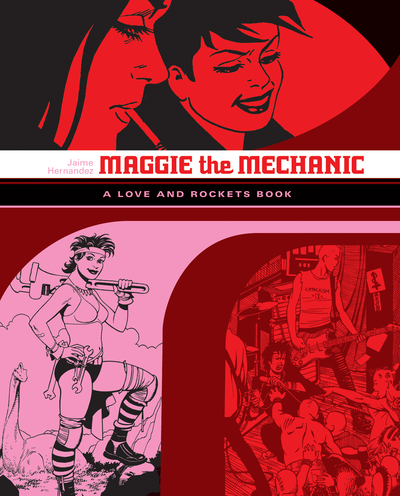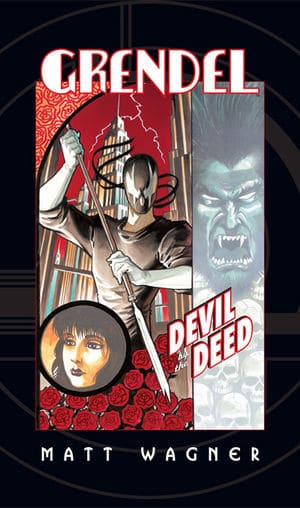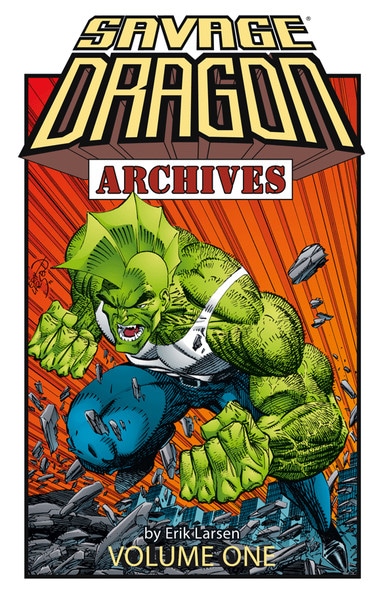We here at Nerds on Earth love comic books. Well, let me rephrase that. We here at Nerds on Earth love comic books from the Big Two. Okay, maybe I should express that in a different manner. We here at Nerds on Earth love Marvel Comics.
That sounds right.
We love Marvel. We’re Marvel Zombies. Our Slack channel is constantly filled with discussions of all things Marvel. DC gets fleeting, and often ignored mentions, but most of the denizens of the Halls of Nerds are Marvel partisans through and through.
I certainly can’t deny that I am also a diehard Marvel fan, but like Thanos suggests, balance is key. I try to maintain a reasonable diet of reading titles from the Big Two and indie publishers. The heroes from the House of Ideas are great, but their adventures can get a little stale. After all, no matter how sweeping or earth shattering a change happens, the cosmic reset button has to be pressed when a new creative team jumps on a book. Character development stalls and the status quo returns. Ho hum.
This sad reality is part of the reason why I check out indie comics. Most of the true dynamic storytelling happens outside of the Big Two. Pound for pound, I would stack up almost any classic story from the Big Two against any number of indie books.
But where to start in the world of indie comics? The alley ways of the indie-verse are vast and varied. Many fanatic fans of the Big Two simply do not know where to start on their journey to the indie aisle. I hope to address that concern in a series of articles over the next several months. I’m going to attempt to provide what amounts to an indie canon for readers to check out. Many indie books are important to the cultural tableau of the comic book genre. Their importance and influence can’t even be denied by chief nerd Clave.
Don’t fear if you don’t see your favorite indie book in this list. This is just the first of several articles exploring the indie canon.
Let’s get into the canon!
<Cue Vivaldi or some other important sounding classical musician>
Love and Rockets
What’s the deal? This classic anthology book from the Hernandez Brothers (Jamie, Gilbert, and Mario) first hit the stands in 1981. The book primarily centers on Gilbert’s characters in the fictional village of Palomar and the adventures of Jamie’s beloved characters Maggie and Hopey in Los Angeles (sometimes referred to as the Locas stories). Both of the main stories offer lively characters, interesting backdrops, and a sense of mysticism and wicked surrealism that most non-superhero books lack. The focus on the daily lives of their characters, their failures and successes, has been a staple from the beginning. And unlike many books, the Hernandez brothers have allowed their various characters to age in real time along with their readers, avoiding the comic book trope of perpetual youth.

Why you should try it? Anthology books can be a tricky proposition – even for the Big Two. However, the Hernandez Brothers succeed in large part by mixing vibrant storytelling with memorable characters. The book has a true punk rock aesthetic throughout its now almost 40 year run. While both the Palomar and Locas stories are central to the various incarnations of the book, L&R also features many one-shot stories, cartoons, and other surrealist slices of life that make reading any L&R issue/volume an adventure unto itself. The book is still being published today, as the most recent volume has returned to the magazine format of yesteryear. It releases on a roughly quarterly basis from Fantagraphics.
Where to start? After nearly 40 years of publication, it might seem like a daunting task to just pick up a dense and varied book like Love and Rockets. I would recommend a couple of places to get started. Starting in 2007, Fantagraphics began releasing paperback omnibus volumes of the original run. Maggie the Mechanic and Heartbreak Soup feature the first Locas and Palomar stories respectively. Those can give readers a ground floor view of both ends of the L&R spectrum. In 2010, Fantagraphics also published a graphic novel called The Love Bunglers, which is another great place for readers to start. Collecting Jamie’s Locas material from the third volume of Love and Rockets called New Stories (a series of graphic novel series), The Love Bunglers follows Maggie and her relationship with two men, Ray and Reno. It’s poignant tale that gives readers a cohesive story in one volume. It’s the quintessential Locas story, and works as great introduction to what L&R has to offer readers.
Stray Bullets
What’s the deal? Dave Lapham’s Stray Bullets is a crime noir story around the lowlife underworld in Baltimore that spans decades, following a large cast of characters from the late 1970s up through the 1990s. As its current publisher Image describes Stray Bullets, it’s “a story about violence, love, and really bad decisions.” Truly, a better description of the story does not exist. Though the cast of characters is large, that shouldn’t turn anyone off. Pretty soon, any reader will fall in love with Beth, Virginia/Amy Racecar, Orson, Spanish Scott, Monster, and yes, even Joey. Barring a decade long hiatus from 2005 to 2014, Stray Bullets has been in print, first from El Capitan and now Image, for a quarter century. That’s nothing to sneeze at!
Why you should try it? Murder, mayhem, and humor are in abundance for Stray Bullets. I have always approached this series as if it were a Tarantino film laid out out in comic book format. Brubaker, Rucca, Miller, and others might have crime comic books out there, but nothing quite beats Dave Lapham. The narrative of the story jumps all over the place, especially in the first volume. The first issue takes place in the 1990s, the farthest point any story has gone, while every successive issue has taken place in the past, and it jumps around from there as well. Each issue is a standalone story, and can be picked up at any time to get a slice of life from the seedy underworld. The cast may be vast like Game of Thrones, but each one is insanely fun to read about and follow.
Where to start? The first trade, The Innocence of Nihilism, is widely available either in its old printing for El Capitan or the new printings from Image. However, if you’re even slightly interested in the story, the Uber Alles edition is the way to go. Collecting the entire first volume of the series, the Uber Alles edition is a 1,200 page tour de force. It collects absolutely everything, and trust me, you’re going to want to read it all. If the $60 entry fee is too steep, smaller collections are available as well.
Grendel
What’s the deal? Matt Wagner’s legendary, award winning, long-running title Grendel is another one of those titles on this list that’s still going on and close to hitting the 40 year mark as well. There have been many to take on the mantle of Grendel over the years, but the original Grendel started out following the criminal exploits of a famed writer Hunter Rose, who, in his costumed identity, operated a vast criminal network. Though Hunter Rose has appeared off and on throughout the years in crossovers and miniseries, there have been many Grendels, ranging from a continuing series legacy heroes, to an emperor, and even a robot!

Why you should try it? Grendel scratches nearly every itch that a comic book fan could ever want. Like Crime? Grendel’s got it. Love Science fiction? Grendel has lasers and apocalyptic future scapes. Like Fantasy? There are werewolves and other beasties! Love crossovers? Grendel has basically met up with every character you could think of. Still looking for current books? Grendel has a new miniseries featuring Grendel Prime, Grendel: Odyssey, coming out in the summer/fall.
Where to start? The original Devil By the Deed, the collection of the first Grendel story (a prose telling of Hunter Rose’s rise and fall) is still in print and available in various, easily found formats. Probably the best way to start with Grendel is to pick up one of the softcover omnibus volumes available from Dark Horse. There are currently six omnibus collections available from Dark Horse. However, folks interested in mixing a little mainstream into their reading should definitely check out the excellent Batman/Grendel stories. Both miniseries are conveniently collected into one volume by Dark Horse.
The Crow
What’s the deal? James O’Barr’s The Crow has been an off and on staple of the indie comic scene for thirty years now. Though most comic fans may be familiar with the original Brandon Lee film, many have probably never actually gone back to check out the comic book it was based off of from the late 80s/early 90s. Like Grendel, many individuals have taken up the role of The Crow over the years, but the general story is almost always the same. The various Crow stories almost always tell the story of a murder victim being returned to life by a supernatural crow to avenge the death of themselves and/or loved ones. The Crow can be potent in its melancholies and brutal in its violence, but revenge stories are bittersweet entertainment that can pull on the heart just as much as they amp up the adrenaline.
Why you should try it? Having probably already seen the film, or at least having a familiarity that one exists, most fans at least know of the character. I would argue that The Crow remains one of the best comic book films of all times (and some of the nerds in the Halls of Slack have laughed greatly over this, but I stand by my assertion: fight me!). Films after the first represent an exercise in diminishing returns, but the comic books are almost always solid reads. The books aren’t feel good, uplifting reads. That has to be stated upfront! This is, afterall, essentially the story of murdered individuals seeking revenge for their untimely deaths. However, The Crow almost always delivers a poignant, heartfelt story no matter what miniseries a potential reader picks up.
Where to start? I would argue (fight me!) that one could do no wrong in picking up almost any Crow miniseries. They are almost always self-contained and at the very least entertaining. However, nothing beats the original Crow miniseries. Gallery Books released a lovely hardcover collection of the original miniseries back in 2011, though copies of the original trade from Kitchen Sink can still be found in the wild. It’s a dark, moody, and atmospheric tale that draws on the aesthetic of the time. I have always thought that it was the comic book version of The Cure’s classic Disintegration album from the same year as its original publication. There’s a poetic beauty to that original miniseries that completely sweeps me away. IDW currently has the publishing rights for the series. Anyone looking for a more current Crow book should definitely check out their excellent Memento Mori miniseries from 2018.
Nexus
What’s the deal? Mike Baron and Steve Rude’s magnum opus Nexus is one of the finest comic books of all time. Pound for pound, blow for blow, I would stand Nexus up against any titan that fans could name from the Big Two. First published by Capital Comics and the First Comics starting in 1981, Nexus tells the story of Horatio Hellpop who receives special powers to destroy mass murderers throughout the galaxy. Nexus becomes a kind of intergalactic cop taking on the worst that the universe can throw at him.

Why you should try it? Do you like superheroes? Great! Do you like science fiction? Even better. Nexus is the perfect mix of the two genres. It outdoes Marvel and DC’s space opera heroes and then some. Fans of Silver Surfer, the New Gods, and Guardians of the Galaxy will find much to love about the adventures of Horatio Hellpop. Baron’s writing is top notch, but there’s no denying that the main draw to Nexus is the stellar artwork from Steve Rude. Page after page, readers will be dumbfounded by Rude’s superb artistic ability, which is a throwback to the styles of Alex Toth and Jack Kirby. Yes, it’s a great read. It’s also a pretty awesome book to look at as well.
Where to start? Nexus has had an on again, off again publishing schedule for many years. According to the official canon provided by Baron and Rude, there are 105 official Nexus issues spread across the main series and the miniseries that followed its original publication. Depending on personal preference and budget, the readers can either start with the first hardcover collection or first softcover omnibus collection from Dark Horse. The omnibus collections are a convenient and cheap way to get in on the ground floor, but the hardcover collections look great on a bookshelf. I went for the latter because this is a story worth getting in the deluxe format.
From Hell
What’s the deal? Was there any chance that I wasn’t going to mention an Alan Moore book in this list? Alan Moore and Eddie Campbell’s From Hell takes a deep, dark look into the infamous Whitechapel/Jack the Ripper murders from 1888-1891. The black and white comics attempts to pierce the mysterious veil around the murders, while also providing a commentary on modern society’s fascination with its grisly past and present. Moore’s prose, coupled with Campbell’s distinctive art style, make this story one of the greats in the entire medium. It may be a work of fiction, but Moore and Campbell convincingly lay out the case for a killer with ties to the Royal family.
Why you should try it? So let’s kill the elephant in the room and move on. Many fans and curious onlookers out there will probably note and remember that there is a truly terrible film version floating around out there featuring Johnny Depp. It’s horrible. If you haven’t seen it, please don’t. This will not be one of those cute, “Oh, it’s so bad it’s good” film viewing experiences. It’s just bad. Period. Ugh, forget the film, okay?
The comic book is the difference between a finely done HBO premium show versus that of a thirty minute session of a four year old retelling their experience watching a Paw Patrol episode. Alan Moore and Eddie Campbell produced a story for the ages. It’s brilliant. There’s not a superhero in sight, but this book packs a punch. The Whitechapel Murders are gut wrenching enough, but the mixture of mystery and mysticism Moore and Campbell bring to the page is palatable.
Where to start? This might seem a no-brainer since this was a limited series. It’s not like there’s a vast, dense network of series to wade through when it comes to From Hell. However, one might be surprised by the variety of editions out there. At nearly 600 pages, From Hell is a bulky book that is begging for a multi-format release. The softcover edition is the classic presentation of the miniseries. If one is looking for an upgraded edition, the hardcover was made available in 2016. Not to be outdone, The Master Edition was produced by Top Shelf in 2018, which represents the series in a colored, remastered, director’s cut format. Fans wanting the Deluxe-ultra-super-awesome From Hell experience can surely expect that edition to be collected in the near future. If that’s not enough, Top Shelf also has a From Hell Companion with articles, notes, and Moore’s research on the Jack the Ripper case. That’s a deep dive purchase, though.
Savage Dragon
What’s the deal? Erik Larsen’s Image comic Savage Dragon is one of the longest running comics both drawn and written by the same artist. With the exception of one issue, Larsen has written and drawn all 230+ (and counting) issues of the title. Despite early appearances in the 80s, Savage Dragon gained fame in the first wave of the Image boom in the early 1990s. Where all of the other original Image creators have left their original books to varying degrees, Larsen has been the lone, consistent voice throughout the company’s entire existence. The book follows the adventures of the Dragon, who initially showed up in Chicago an amnesiac. Eventually the Dragon joins the Chicago PD to fight all of the mutated freaks that have cropped up in recent years. Though the story has evolved beyond that original premise, it remains one of the zaniest reading experiences on the stands today.

Why you should try it? This book is insanely fun to read. I don’t feel like I need to write more beyond that. It’s just fun. Many of the books out there (even on this list!) can be kind of dreery at times. Not Savage Dragon. It’s manic in its joy. Savage Dragon is a love letter to the comic book medium itself. There’s nothing predictable about Savage Dragon, and that’s part of the fun!
Where to start? There are a few collections of the first miniseries, Baptism by Fire, out there floating around. Later reproductions included reworkings of the original material, but the story essentially remains the same. The single issues are also easily found in shops and dollar bins. However, probably the best way to initially get on board is to seek out the recent Savage Dragon Archives omnibus. These are black and white “phone book” style reprints that feature around 25-30 issues each. These volumes are convenient, but if you enjoy the first volume, you will probably want to skip over to the color trades. Another great place to begin your Dragon reading is with the A New Beginning trade. This collects issues 193-198 of the series and is about Malcolm Dragon, the son of the title character, taking over as the main protagonist of the title.

